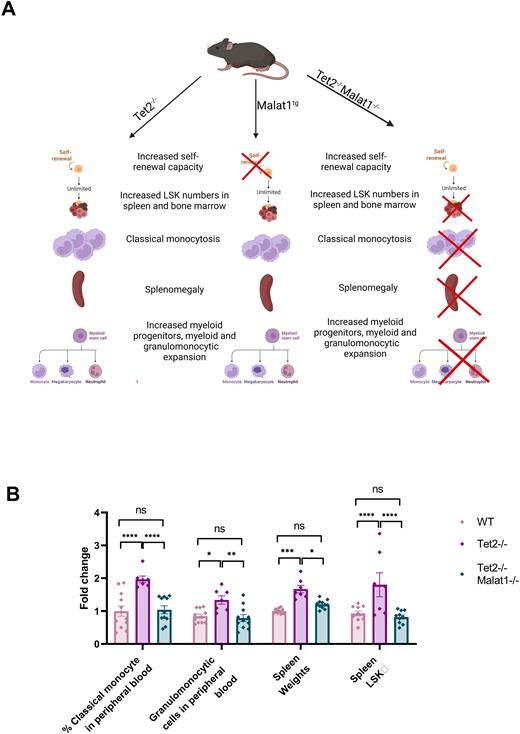Abstract
Ten Eleven Translocation 2 (TET2) is a dioxygenase which regulates gene expression by oxidizing 5-methylcytosine to 5-hydroxymethylcytosine. Loss of function mutations in TET2 occur in up to 58% and 30% of myeloid malignancies and clonal hematopoiesis respectively. Loss of TET2 function also occurs with isocitrate dehydrogenase 2 (IDH2) mutations in Acute Myeloid Leukemia (AML) via 2-hydroxyglutarate (2-HG). Genetically engineered murine models (GEMM) of Tet2 deficiency produce a Chronic Myelomonocytic Leukemia (CMML)-like phenotype with splenomegaly, granulomonocytic expansion and increased bone marrow hematopoietic stem and progenitors (LSK). Further, bone marrow mononuclear cell (BMNC) transplant models of Tet2-/- clonal hematopoiesis suggest that this myeloid expansion leads to enhanced inflammation and increased cardiovascular disease risk. However, the downstream effects of TET2 loss of function leading to this phenotype are unknown. Here we show that TET2-deficient granulomonocytic expansion and inflammation are mediated via MALAT1, a long non-coding RNA overexpressed in several malignancies.
MALAT1 expression was increased in BMNCs from IDH2 mutated AML patients (n=152 WT n=17 mutant IDH2, p=0.04). Increased MALAT1 expression was also seen in human and murine models of TET2 deficiency including isogenic IDH2 mutated TF-1 cells (5 biological replicates p=0.005), 2-HG treated leukemia cell lines (2 biological replicates p<0.0001) and BMNCs from Tet2f/f mice (n= 7/grp p=0.005). To evaluate the impact of Malat1 on normal and Tet2 deficient hematopoiesis we utilized the Malat1tg overexpression and Tet2-/-Malat1-/-GEMM models. Similar to Tet2-/- mice, bone marrow (n=4/grp p=0.02) and spleen (n=8/grp p=0.004) LSK numbers were increased in Malat1tg mice compared to control. However, unlike Tet2-/-LSKs, MALAT1tgLSKs did not show increased self-renewal in serial in vivo competitive transplants. Further, depleting Malat1 in Tet2-/- mice did not rescue the increased self-renewal capacity seen in Tet2-/- LSKs. Collectively, these data suggest that Malat1 overexpression is sufficient for LSK expansion but does not impact LSK function.
Splenomegaly, myeloproliferation and extramedullary hematopoiesis is a phenotype termed Preleukemic Myeloproliferation (PMP) and is predictive of myeloid neoplasm development in Tet2-/- models (Meisel M et al, Nature 2018). Consistent with a role of Malat1 in PMP (Fig A), Malat1 overexpression recapitulated PMP at 8 (n=10/grp p<0.0001) and 20 (n=10/grp p=0.0005) weeks. Malat1 overexpression was also associated with an increase in classical monocytes in the peripheral blood- a hallmark of CMML (8 weeks n= 7/grp p<0.0001, 20 weeks n=10/grp p=0.0007). This was recapitulated in Tet2-/-mice (n=3/grp p=0.001) and CMML patients with TET2 mutations (n=27 mutant TET2 v 109 WT, odds ratio 5.6 p= 0.001). Finally, depleting Malat1 in a Tet2-deficient GEMM rescued PMP (n=4 Tet2-/-Malat1-/-v 5 Tet2-/-p=0.01) and classical monocytosis (n=2/grp p=0.002) suggesting that Malat1 overexpression is both sufficient and necessary for PMP in Tet2 deficient leukemia. This impact was also observed in recipients in BMNC competitive transplant experiments (Fig B).
Initial insights into the molecular mechanism underlying the role of Malat1 in PMP were derived from analyzing competitor and host cells during in vivo competitive transplants. Interestingly, transplant recipients with Malat1tg LSK demonstrated myeloid and granulomonocytic expansion in both donor and non-donor cells suggesting that the effects of Malat1 overexpression are, in part, cell extrinsic. Consistent with this hypothesis and the impact of NF-kB on inflammatory cytokine secretion and Tet2-/- PMP, we show that MALAT1 deletion in human leukemia attenuates NF-kB activity by enhancing the phosphatase activity of PP2A. Further, Interleukin 6 (IL-6), a major downstream target of NF-kB and potent activator of myelopoiesis in response to inflammatory stimuli, was increased in the plasma of MALAT1tg mice (n=8/grp p=0.01) suggesting a possible cell-extrinsic mechanism for Malat1 dependent PMP. Ongoing studies are focused on demonstrating that IL-6 is necessary for Malat1 dependent PMP. Our current data provides hitherto unknown insights establishing MALAT1 as a major effector of TET2 loss of function which may lead to novel therapeutic options in TET2 deficient myeloid neoplasms.
Disclosures
Komrokji:AbbVie: Consultancy, Honoraria, Speakers Bureau; Acceleron Pharma: Consultancy; Geron: Consultancy; PharmaEssentia, Takeda: Honoraria, Membership on an entity's Board of Directors or advisory committees; Taiho Oncology: Consultancy, Membership on an entity's Board of Directors or advisory committees; Servier: Consultancy, Honoraria, Speakers Bureau; CTI BioPharma, Innovent: Honoraria, Membership on an entity's Board of Directors or advisory committees; Novartis: Consultancy, Membership on an entity's Board of Directors or advisory committees; Jazz Pharmaceuticals: Consultancy, Honoraria, Speakers Bureau; Bristol Myers Squibb: Consultancy, Honoraria, Membership on an entity's Board of Directors or advisory committees, Research Funding, Speakers Bureau. Padron:Stemline: Honoraria; Taiho: Honoraria; BMS: Research Funding; Syntrix Pharmaceuticals: Research Funding; Kura: Research Funding; Incyte: Research Funding; Blueprint: Honoraria.
Author notes
Asterisk with author names denotes non-ASH members.


